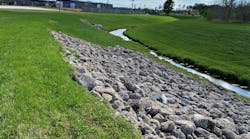The company has been doing a lot of resurfacing projects recently, protecting nearby wetlands and other environmentally sensitive areas.
“We focus more on county roads with limited traffic where we’re putting silt fence along the side of the road so the paving operation isn’t washing into any adjacent waterway.”
Using the tommy in conjunction with durable fabric makes for greater stability for the silt fence, Mallard says. “It has to have a more durable fabric because of the way it’s being installed. You’re actually installing the stakes in a separate application. They‘re not coming pre-staked, so when you have an area that gets damaged, it’s much easier to add more stakes and add more fabric; it’s a lot easier to repair.”
To replace the silt fence, Mallard will use a pick axe to retrench and then install the fabric. “We have the extra stakes,” he notes.
“Say that you have more sediment in one area,” he adds. “You can put stakes every 3 feet, adding additional stakes. The tommy is going to place the fabric much better than the typical trencher. When it rolls the fabric in, you know it’s in. You can barely pull it up at all. With a trencher, you could probably pull it up in any given spot, depending on how well you maintain it. People can be very critical of it. If you don’t set it properly, you’re going to end up redoing a lot of it.”
Mallard says that when his company uses the tommy to install the silt fence, they’re getting the J-shaped hook in the fence, making a better barrier.
“The common method to install it is the pre-staked silt fence,” he says. “Most people don’t get the depth that they need to get that J-hook. So the fence stands a lot taller above the ground. One of the criticisms we get is our fence looks lower to the ground because a lot more fabric is pinched in. People keep thinking our fence isn’t tall enough. But we are well into the state requirement of 18 to 24 inches above the ground.
“It just looks funny because most silt fence you see is installed improperly. We pride ourselves in getting it right and training the contractors we’re working for to expect how to install silt fence correctly. I’ve been certified since 2006 to inspect silt fence. I know how to do it and why we do it.”
Mallard says many of the challenges he faces in Florida involve dealing with wetlands and imported soils.
“There is a lot of variation in soils, so you may get a job closer to the beach where a lot of your soils are sandier. When you’re trying to control washout, you may have sandy material underneath the topsoil material that was imported to grow grass, and then the second you change your grades, you’re going to end up with washout,” he says.
Some other areas may have the equivalent of beach sand, Mallard says. “You’re never going to get the material to stay in place, but, in my opinion, if you’re in an area where you’re dealing with beach sand, you’re not really going to deal with erosion, because the moisture is going to settle into the ground.”
Weather can present more challenges.
“When we have wet seasons, they’re very wet and you’re dealing with a lot of rain—up to two inches a day—and it can really change the outlook of your project,” says Mallard. “The heat is battering the silt fence during dry weather, and when a storm comes through, you’re replacing half of it,” he says. “Florida has extreme weather conditions that change in hours, so it’s very hard to predict.”
Mallard says it’s important to get people to understand that silt fence is there to control sediment.
“Wherever the water is flowing, you need to have your stakes on the opposite side pushing against that flow,” he says. “Most people just see silt fence as a line in a spec. They install it and they don’t understand why they are installing it. They just know that someone needed it. Once you tell somebody this is why it’s there and the purpose it’s serving, they get it.”
Learning to install silt fence and learning to use the tommy entails a brief learning curve, Mallard says. “Brian, who is part owner with us, is a firefighter by trade and had never installed silt fence before,” he says. “Now he pretty much will run all of my jobs. That’s in less than two years. As far as the tommy, he learned it on one job and now he can run it efficiently. It’s very easy to learn.”
Because Mallard didn’t want his part-time work to hinder his full-time work, it was important to him to find equipment that would help him from having to hire more labor.
“We’ve been pretty successful in the year and a half we’ve had our business, and I think the tommy has given us a definite advantage,” says Mallard.






